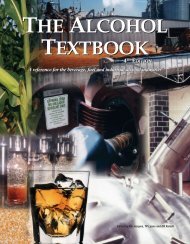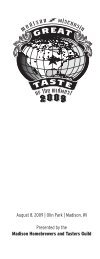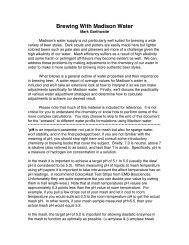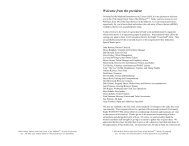The Compleat Distiller
The Compleat Distiller
The Compleat Distiller
Create successful ePaper yourself
Turn your PDF publications into a flip-book with our unique Google optimized e-Paper software.
THE COMPLEAT DISTILLER 99<br />
<strong>The</strong>se three equations, plotted for ethanol mol fractions ranging<br />
from 0 to 1 and temperatures from 78.5ºC to 100ºC, result in the<br />
following constant pressure plot. <strong>The</strong> lower curve is called the<br />
bubble line, because it shows the temperatures at which the mix<br />
begins to boil, and the upper curve is called the dew line,<br />
because it indicates the temperature at which vapor first<br />
condenses. Anything below the bubble line is liquid, and<br />
anything above the dew line is vapor. <strong>The</strong> area enclosed by the<br />
two curves represents points where liquid and vapor are in<br />
dynamic equilibrium.<br />
Fig. 8-5<br />
This plot is extremely useful Because it lets you graphically plot the progress of a distillation. If, for<br />
example, you start with 11% ethanol in the boiler, the first vapor to come off contains 23% ethanol. If<br />
this is condensed and re-boiled, the resulting vapor would contain 40% ethanol, and so on up to the<br />
maximum possible concentration of around 96% ethanol. Ethanol has a maximum concentration lower<br />
than 100% because it forms an azeotropic mixture with water. We used charts like this in Chapter 2 to<br />
illustrate what happens with repeated distillations.<br />
<strong>The</strong> stages in this plot are called theoretical plates. This name comes from the plates or trays inserted<br />
in large commercial distillation towers to facilitate the evaporation and condensation process. <strong>The</strong>se<br />
plates serve the same purpose as the packing used in small-scale columns. On the diagram, a<br />
theoretical plate is marked out by going vertically from the bubble line to the dew line, and then<br />
horizontally back to the bubble line.<br />
In the example starting at 11%, 7 plates are needed to reach the top concentration, and the first plate is<br />
the boiler itself. If a packed column is 100 cm long, and the temperature levels out at the boiling point<br />
of ethanol 60 cm up, then the Height Equivalent <strong>The</strong>oretical Plate (HETP) for this packing would be<br />
60/6 = 10 cm. If you are interested in calculating the number of theoretical plates needed in a column,<br />
you should use the McCabe-Thiele equations, and we use a simplified form of these in a moment when<br />
discussing Reflux. On the internet, Tony Ackland's website (see Appendix 8) gives an excellent<br />
description of them. Tony is a chemical engineer in New Zealand with a great interest in the hobby of<br />
distillation.









